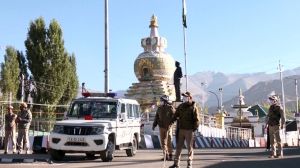Midwives are busy, tense in Centre’s maternity ward
NEW DELHI, OCTOBER 27: The joke currently making the rounds in the North Block goes like this: Uttaranchal and Chattisgarh should be compa...

NEW DELHI, OCTOBER 27: The joke currently making the rounds in the North Block goes like this: Uttaranchal and Chattisgarh should be compared to a normal delivery in a maternity ward. But Jharkhand will not be so lucky. Here the scene to follow could well be straight out of a Hindi film when a perspiring doctor comes out and announces grimly: “We have saved the baby but the mother has died.”
No wonder, then, that Special Secretary in the Home Ministry, S.B. Mahaptra, likens his job to that of a midwife. “Our job is to ensure the smooth birth of the new states by co-ordinating with all the departments responsible for the easy transfer.”
Hectic, almost round-the-clock flurry of work is being undertaken by over half a dozen central ministries. They are now giving finishing touches to the birth of three states.
Chairman of the Advisory Committee for the Re-Organisation of UP, MP and Bihar, specifically pertaining to the All-India Services Division, U.C. Agarwal, believes his job is that of managing well the break-up of a large joint family. Says Agarwal: “Property has to be divided, bank accounts and resources have to be apportioned according to size, staff has to be picked and sent to their new jobs, the system has to be duplicated in the most efficient and economic way.”
The task is enormous. With the deadline looming large — Uttarakhand and Chattisgarh by November 1 and, Jharkhand on November 15 — matters are coming to a head. Even basic essentials have to be in order before the state is born.
Explains Mahapatra, “Unless you have a capital, we can’t set up the high court. After all, we need the chief justice to give the oath of office to the new governor and chief minister.”
The Agarwal Committee has the important task of maintaining the character of a stable administrative system already laid out in the All-India Services Act, 1951. For instance, as Agarwal explains, it is important to maintain the ratio of the field and secretarial posts, and that the total cadre strength of the state should take into consideration the percentage of insider-outsider ratio.
Agarwal has been racing against time all these days to come out with his final report on cadre distribution that at one stage threatened to derail the very formation of states. Senior officials in the Finance Ministry are busy figuring out intricate splitting up of funds, taxes and central bonanzas between the parent states and their off-spring. Agarwal submitted his report to the Central Government on Tuesday.
Half a Kilometre away from North Block at the Planning Commission building sits M.D.Asthana, principal advisor for the Bihar Cell set up by the central Government. He was a trifle slow in leaving the blocks and the delay is showing: The cell, though officially ticking, is still way behind coming out with a solution to the economic wilderness Bihar is going to find itself in.
A senior Finance Ministry official remarked, “Once cut off from Chattisgarh, Bihar will be left with guns, floods and institutions set up by Jagannath Mishra.”
The Law Ministry too has its hands full, and the work as yet is half done. An important decision concerning the location of principal seat of High Court for Uttaranchal still hangs in balance. In the case of Chattisgarh and Jharkhand, the Ministry has already okayed Bilaspur and Ranchi, respectively, for the principal seats. The delay for Uttaranchal has already sparked off lawyers’ protests in various parts of Garhwal and Kumaon.
Another hiccup on the legal front which, surprisingly, has escaped attention: the strength of judges in the new states (and the much trickier part of their transfer from the parent to new states) hasn’t yet taken a final shape.
Agarwal’s woes were compounded by the fact that not many IAS and IPS officers wanted to move out of UP and MP. The formula of cadre-distribution suggested by him in his interim report consisted of 50 per cent `insider’ officers (that is those were born or did their matriculation in new states). But the hitch came when the states refused the deal on the next 50 per cent.
Ajay Vikram Singh, a senior IAS officer of UP is among the very few who have reportedly volunteered to move over to Uttaranchal. Singh, according to a senior Home Ministry official “loves hills and wants to set an example by opting for Uttaranchal.” But such voluntary choices are hard to come by — Aggarwal will vouch for it.
In Bihar, the situation is exactly opposite. In their rush to leave the `killing fields’ of Bihar for the `prosperous fields’ of Jharkhand, even those officers supposedly close to Laloo Prasad Yadav are switching loyalties. Agarwal, sources say, has been repeatedly apprised of this problem by the senior Bihar officers. This, perhaps, is the reason for his going for a uniform cadre distribution for the three new states.
On the job since August 29, Agarwal has held at least one meeting a day with senior officials of UP, MP and Bihar. The Finance Ministry officials, on the other hand have held 12 meetings with the state representatives, apart from numerous `inter-Ministerial’ brainstorming sessions.





- 01
- 02
- 03
- 04
- 05


























